Chinese Name: 华清池 Pronunciation: huà qīng chí
English Name: Huaqing Pool, Huaqing Palace
Building Time: 644 BC
Best Visiting Time: Summer and Autumn (May to October)
Popular Activities: Lantern Show; Guessing Lantern Riddles
Suggested Visiting Hours: Half day or one day
Tourist Area: About 85,560 square meters.
Address: No.38, Huaqing Road, Lintong District, Xi'an City, Shaanxi Province.
Building Function: A place functioning as a royal garden and a hot spring pool for the royal family to enjoy themselves.
| Tickets | All Year Round |
| Admission Fee | 120 yuan |
| 12·12 Xi’an Incident Performance | 258 yuan |
| “Song of Everlasting Sorrow” Performance | 268yuan-368 yuan (Prices vary according to different seat areas.) |
1. Children under 1.2 meters and senior citizens over 70 years old (with a valid ID card or passport) are free of charge for the admission ticket fee.
2. Children under 1.3 meters are free of charge without a seat for the “Song of Eternal Sorrow” Performance.
| Gate | Opening Hours |
| Wangjing Gate (the West Gate) | 7:30-18:00 |
| Peony Gate (Mudan Gate) | 7:30-17:30 |
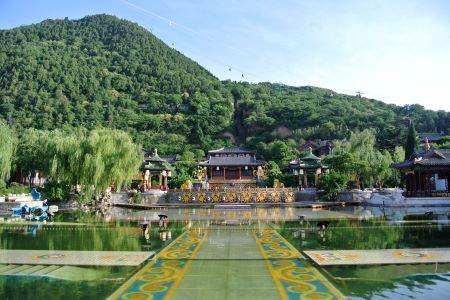
Huaqing Pool Scenic Spot also called Huaqing Palace and Li Palace is a palace and building complex with Tang Dynasty architectural style centered on hot springs. It is located 30 kilometers east of Xi'an and is adjacent to the eighth wonder of the world--- the Terracotta Warriors and Horses Museum, at the foot of the Lishan Mountains. Because of the rich hot spring resources, Emperors of the Zhou Dynasty, Qin Dynasty, Han Dynasty, and Tang Dynasty used to build their palace here for escaping the chill winter.
Huaqing Pool was expanded on a large scale in the early Tang Dynasty (618-907). And it became the most favorite palace for the Emperor Xuanzong of the Tang Dynasty. According to the historical record, he has visited here 36 times in 40 years. At that time, Chang’an (now we call it Xi’an) was the capital. And people call the Huaqing Pool “the second Chang’an”.
Today’s Huanqing palace was built based on the original site following many repairs and expansion. It covers an area of 85,560 square meters and included many sightseeing points such as the Tang Dynasty Hot Spring Pool Relic Museum, the former site of the Xi’an Incident-Five Room Hall, the Nine-dragon Lake, Furonghu Lake Scenic Area, and the Tang Dynasty Pear Garden (opera theatre) Relics Museum. Its historical buildings, beautiful natural scenery, and natural hot springs attract more and more tourists to spend their leisure time here.
Besides its excellent natural condition, it is also famed for its historical story. The love story between Emperor Xuanzong and his concubine Yang Yuhuan happened here. Yang Yuhuan is a peerless beauty. Poets in the Tang Dynasty wrote poems to evaluate her, saying that her beauty could overshadow all the concubines. And Yang Yuhuan is proficient in music and good at dancing. Emperor Xuanzong of the Tang Dynasty is a versatile, wise, and decisive emperor. Although there is a 34-year-long age gap lies between Emperor Xuanzong and Yang, they are very affectionate. Sometimes, Concubine Yang will dance and Emperor Xuanzong will play the drum for her as accompaniment. In 744 AD, Emperor Xuanzong ordered the expansion of Huaqing Palace and the construction of Begonia hot spring pool, especially for Concubine Yang. They spent a lot of memorable moments there. But because of the But then, a mutiny broke all the peace and love. The rebels demanded Emperor Xuanzong to kill Yang Yuhuan. For the safety of the country, the emperor finally chose to let his beloved woman commit suicide. This has also become a beautiful but sad love story that has been passed down through the ages.
It is said that as far back as 3000 years ago in the Western Zhou Dynasty (1046 B.C.-771 B.C.), the Huaqing Pool had become a resort for the emperor. At that time, it was called the “Star Hot Spring”.
In 569, the 4th year of the reign of Emperor Wu of the Northern Zhou Dynasty, the emperor ordered the construction of the royal hot springs.
In 583, the third year of the reign of Emperor Wen of the Sui Dynasty, thousands of pines and cypresses were planted, and houses began to be built around the hot springs.
In 644, the 18th year of the reign of Emperor Taizong of the Tang Dynasty, it was given the name “Tangquan Palace” (Hot Spring Palace).
In 747, the 6th year of the reign of Emperor Xuanzong of the Tang Dynasty, it was renamed Huaqing Palace (Huaqing Pool).
On December 12 in 1936, two generals of Kuomintang, Zhang Xueliang and Yang Hucheng, launched the famous “Xi'an Incident” in Huaqing Pool.
On August 6 in 1956, it was listed as the first batch of key cultural relics protection units of Shaanxi Province.
Since 1959, it has been expanded on a large scale.
In 1961, it was publicized as one of the national key cultural heritage protection units by the China State Council.
In 1982, it was listed in the first batch of key scenic spots in China. In February of the same year, the Five Room Hall, which is the former site of the Xi'an Incident, was listed as the second batch of key cultural relics protection units of China.
In 1996, the Huaqing Pool was announced by China State Council as the fourth group of key cultural relics protection units of China.
In 1998, it was awarded the title of “one of the most famous gardens in China” by the Ministry of Construction.
In 2000, it was approved by the China National Tourism Administration as the National 4A-Grade Tourist Attraction.
In 2007, it was approved by the China National Tourism Administration as the National 5A-Grade Tourist Attraction.
On April 13 in 2018, it was shortlisted into the tourism project “Top 100 Magic sightseeing in Northwest China” and ranked second.
China is one of the countries with the largest number of hot springs in the world. Hot springs in Lishan Mountains have been developed for a long time, enjoying the reputation of “The first Royal Spring in the World”. As early as 6000 years ago, Chinese ancestors began to use the hot springs in Lishan Mountains.
There are 4 hot spring sources in the Huaqing pool. The existing hot spring pool has a radius of about 1 meter. The water is crystal clear and the steam rises slowly. The hot spring produces 113 tons of water per hour, and the water temperature remains at around 43°C throughout the year. One of the four hot spring sources was discovered in the Western Zhou Dynasty, and three of them were developed in recent years.
Because Hot springs generally contain a variety of active trace elements and the temperature of spring water is often higher than 30°C, Hot springs can have medical effects on the following diseases: obesity, motor system diseases (such as trauma, chronic rheumatoid arthritis, etc.), nervous system diseases (nerve damage, neuritis, etc.), early mild cardiovascular diseases, gout, skin Sickness, etc.
The temperature of the low-temperature hot spring is 38℃~40℃. It has a calming effect on the human body. It has certain effects on neurasthenia, insomnia, high blood pressure, heart disease, rheumatism, low back and knee pain, and colds.
The temperature of High-temperature hot springs is above 43°C and has an exciting and stimulating effect on the human body. At the same time, it has a significant effect on cardiovascular diseases, which can improve physical fitness, enhance human immunity, and prevent diseases.
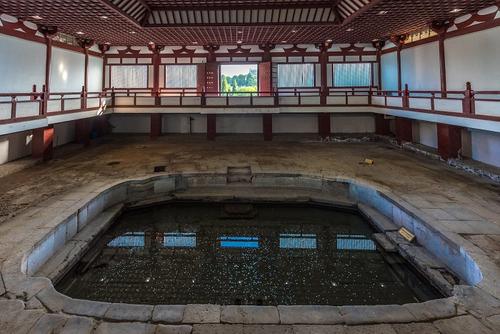
The relic of the Imperial Hot Springs of the Tang Dynasty was discovered in April 1982. After more than three years of excavation, five imperial hot spring pool sites were discovered. Among them, the “Lotus Hot Spring” and “Begonia Hot Spring” are for Emperor Xuanzong and his concubine Yang Yuhuan. The “Stars Hot Spring” bathed by Emperor Taizong of the Tang Dynasty. At the same time, the precious ancient relics---Three Colour Ridge Beast and Lotus Pattern Bricks were also unearthed here, as well as more than 3000 pieces of cultural relics of the Neolithic Age, Qin Dynasty, and Han Dynasty.
Through textual research, these ancient imperial hot springs are completely consistent with the description in the historical records. It is a group of relatively complete architectural sites in Huaqing Pool. The discovery of these sites is an important achievement of archaeology in China, which provides precious historical materials for the study of hot spring culture, feudal hierarchy, and palace architecture of the Sui Dynasty and Tang Dynasty.

Pear Garden in Huaqing Pool is the most famous royal opera theatre in China. Some small hot spring pools are founded here that are specially used by the opera actors. Due to the strong national strength, prosperous economy, and emperor's love and esteem to music and dance, a large number of music and dance artists were gathered in the Pear Garden at that time. They combined foreign music with local music. Therefore, the music and dance art of the Tang Dynasty is in the heyday of ancient China.
Moreover, the Pear Garden is the first royal music and art school in Chinese history. It functions as the center of music, dance, opera, and drama, focusing on teaching and performing. Many famous opera actors in Tang Dynasty have been studied in the Pear Garden. Thus, the Pear Garden is honored as the origination of Chinese opera art.
The Pear Garden witnessed the love story between Emperor Xuanzong and his concubine Yang Yuhuan. Emperor Xuanzong is good at music, and Yang Yuhuan is skilled in playing instruments and singing. They created many wonderful songs and dances in the Pear Garden through the years. Unfortunately, the most famous work they created which named Ni Chang Yu Yi Qu has been lost for a long time.

Entering the Furong Garden, the first thing that catches your eyes is two tall green trees that many red cloth strips are hanged on. The branches of the two trees intertwine with each other as they grow. Ancient people often used such a tree as a metaphor for lovers who are together forever. Tang Xuanzong and his concubine Yang Yuhuan once made an oath here saying that in heaven let us be two birds flying ever together, and on earth we are willing to be two trees with branches interlocked forever. Even now, many tourists still will write their good wishes to love on the red cloth strips and hang them on the tree to hope it can be realized. That is why there are many red cloth strips on the tree.
There is Changsheng Hall in the Furong Garden. Here you can enjoy a multimedia show presented through holographic projection and fantasy imaging technology. This show mainly included several parts such as Concubine Yang entering the palace, Concubine Yang and Emperor Xuanzong enjoying singing and dancing in Pear Garden, Concubine Yang bathing in Begonia hot spring pool, Concubine Yang and Emperor Xuanzong making a vow of love on Valentine’s Day, and the meet in Emperor Xuanzong’s dream after Concubine Yang died. Through this performance, you can feel this love story more truly.
Next to the Furong lake, the Nine-dragon Lake is situated on the south of the Pear Garden. With an area of 530 square meters, it is an artificial lake constructed in 1959. People compared this sparkling lake as a Yaochi which is an extremely beautiful lake in heaven in Chinese myth.
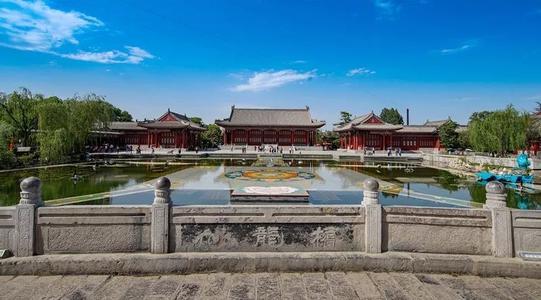
Walking around the lakeside, it seems that you are walking in the Tang Dynasty and you will be amazed by the wonderful scenery. A long bridge called Nine-dragon Bridge, which crosses from east to west divides the lake into two parts: the upper lake and the lower lake. There are modern fountains in the upper lake, and a historical dragon boat in the lower lake. Besides these, you will see many buildings with Tang Dynasty building style surrounded by lush pines, cypresses, and weeping willows.
Walking from the lake to the west bank, you will see an antique corridor, which is not only the connection of Nine-dragon Lake and Furong Lake but also a good resting place for tourists. Sitting in the corridor, you will see refreshing scenery with a crystal-clear lake and the weeping willows on the shore that are swaying in the wind.
At night, Nine-dragon Lake is surrounded by dynamic color lights. During the evening, a stage with nearly 1000 square meters slowly emerges from the surface of the lake. This stage takes the Lishan Mountains and the Nine-dragon Lake as the background. China’s first large-scale live historical dance drama "The Song of Everlasting Sorrow" is performed here. With stage lighting, computer-generated imagery, and other performance techniques, this touching love story of Emperor Xuanzong and Concubine Yang are told to people in another way.

Frost Flying Hall, also called Feishuang Hall in Chinese, is located in the west of the Pear Garden and on the north bank of the Nine-dragon Lake. It used to be the bedroom of Emperor Xuanzong and his concubine Yang. It is named after a beautiful story. It was said that every winter when Emperor Xuanzong and Yang came to the hot spring to take a bath, it will snow. But before the snowflake touches the ground, it will be evaporated in the air by the heat of the hot spring, and the steam will become frost. So Emperor named this hall Frost Flying Hall.
The red pillars, roof beams, and walls are of the Frost Flying Hall are carved with well-designed patterns. In front of the hall, stone cattle and stone lions stand majestically. On both sides of the hall, various kinds of flowers are planted which makes this historical building more vibrant. There are another two magnificent halls named Yichun Hall and Chenxiang Hall standing parallelly on both sides, facing each other. Today's Frost Flying Hall has become a place for Huaqing Pool to receive distinguished guests.
Five room Hall is another historical site in Huaqing Pool. In 1982, it was listed as the second group of national key cultural relics protection units.
Five Room Hall, connected by five single rooms, was built in the late Qing Dynasty. It is a brick-and-wood building, with Lishan Mountains in the south and Lotus Pond in the north. It used to be the refuge of Empress Dowager Cixi after Beijing was invaded by the Eight Power Allied forces in 1900.
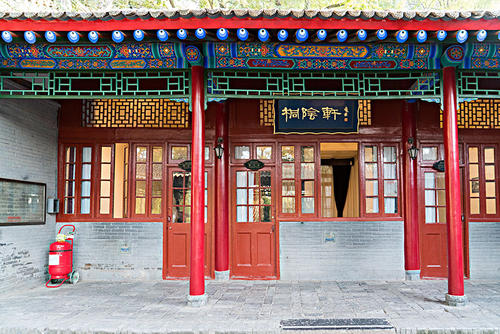
It was also the temporary residence of Chiang Kai-Shek, the leader of the Chinese Kuomintang. In 1936, Chiang Kai-shek came to Xi'an twice. He used Huaqing Pool as a temporary office at the time and lived in Five Room Hall. At that time, Chiang Kai-shek advocated civil war. He believes that only by eliminating all the other parties’ members except Kuomintang, can we begin to fight against foreign aggression. However, the two generals named Zhang Xueliang and Yang Hucheng advocated that all the Chinese should unite to fight foreign aggression and protect China together instead of starting the civil war. Because Chiang Kai-shek resolutely opposed their idea, on December 12, 1936, the two generals launched military remonstrances to force Chiang Kai-shek to abandon the civil war. This is the famous Xi’an Incidence. Xi'an Incident is a turning point for China from the civil war to a foreign war.
Bullet marks coming from the fierce battle of the Xi'an Incident still exist on the windows and walls. Almost all things in each room are copied and placed according to the original appearance. So, you can still feel the tense atmosphere when you will into the rooms.
Next to the Five Room Hall, there is a hot spring pool modeled after the hot spring pool where Concubine Yang bathed in the Tang Dynasty. In 1957, Mr. Mei Lanfang, a famous Chinese opera master, visited Huaqing Pool, and later he named the pool “Yangfei Pool” which means Concubine Yang’s pool.
Lishan Mountains is a branch of the Qinling Mountains, with an altitude of about 1302 meters. It is an isolated horst fault-block mountain in the rift belt of Wei River formed by the Qinling Mountains’ uplift. From afar, the mountain looks like a horse.

Legend has it that in ancient times, the sky and the earth collapsed and the people suffered. The Goddess of Lishan Mountains brought her two daughters to refine the stone and repair the sky. Goddess of Lishan Mountains and her eldest daughter refining stones, and the youngest daughter turned into a flying horse and carried her mother and sister fly to the sky to make up the sky. After the sky was repaired, an evil black dragon came out from the ground. The goddess of the Lishan Mountains and her two daughters tried their best and subdued the dragon. After the fierce war, the youngest daughter lay down and rested due to excessive fatigue. When she woke up and saw the beautiful scenery, she decided to stay here forever. She became a big mountain, looking like a black horse lying on the ground. This is Lishan Mountains.
As an important part of the Huaqing Pool scenic area, Lishan Mountains is famous for the sunset. When the sun goes down in the west, the mountain is covered in the golden sunset glow, forming a picturesque landscape. Besides the natural beauty, you can also find many cultural relics on the Lishan Mountains such as the Beacon Tower, the Sunset Pavilion, the Remonstrance Pavilion, and Emperor Qinshihuang's Mausoleum.
The most eye-catching one is Emperor Qinshihuang's Mausoleum, which was built at the foot of the Lishan mountains. It is the largest underground mausoleum in the world. The mausoleum is approximately square, with a flat top and a slightly stepped waist. It is 76 meters high, 345 meters long from east to west, and 350 meters wide from north to south, covering an area of 120,750 square meters.
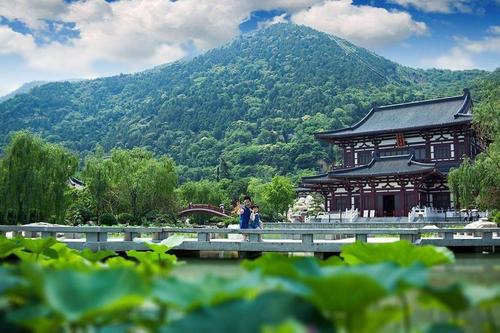
In ancient China, it was very important for the emperors to build their tombs. They paid great attention to Fengshui and believed that a good location for the tomb can bless their descendants. Qin Shihuang, as the first emperor in Chinese history, chose his tomb in Lishan Mountains. This shows that Lishan Mountains had been regarded as a good place even 2000 years ago.
According to historical records, there are countless treasures in the underground palace of Qin Shihuang's mausoleum as if he brought all his glory and wealth into the underground. The Qin Dynasty is a glorious page in Chinese history, and this mausoleum shows the highest achievements of the Qin civilization. However, due to the limitations of current technology, the Mausoleum of Qin Shihuang has not been fully excavated.
The Beacon Tower is an ancient wartime base for delivering war reports and dispatching troops. Because there is no fast way to send a message to others. If the enemy invades, soldiers here will fire the combustibles on the Beacon Tower. Because the Bacon Tower is very high, the smoke will be seen even several miles away. And then other soldiers from all the distance will come for help. This is the most important function of Bacon Tower in ancient times. And now, the Beacon Tower that you will visit has a history of more than 3000 years old. Situated in the west of the Lishan Mountains, it is the highest scenic spot on the Lishan Mountains where you can overlook the magnificent scenery of the scenic area.
The Beacon Tower is famous for a story of an ancient emperor in China, which is also jokingly considered as the Chinese version of the fable “Wolf Is Coming”. It was said that at the end of the Western Zhou Dynasty, the King of Zhou married a woman named Bao Si who is as beautiful as a fairy. However, it was a pity that Bao Si never smiled since she got married. The king was very distressed and tried many ways to make Bao Si smile but all failed. A treacherous minister got to know this thing and provided an idea for the king. So, one day the king ordered the soldiers on the Bacon Tower to fire combustible for no reason. Of course, all the feudal princes in a distance saw the smoke on the Bacon Tower and they thought the king is in danger. So all of them arrived here in a short time.
Everyone was already sweating profusely when they arrived. However, what they saw was the happy and peaceful scene of everyone singing and dancing on the Beacon Tower. They know that they were cheated and all left angrily. At this time, when Bao Si saw the embarrassed appearance of the feudal lords, she finally smiled. Then the king was incredibly pleased and greatly rewarded the treacherous officials. However, in 771 B.C., when the enemy invaded the state, the king used the smoke on the Beacon Tower to deliver the war message to others again but this time no one came to save him. So, the king was killed in the war and the Western Zhou Dynasty perished from then.
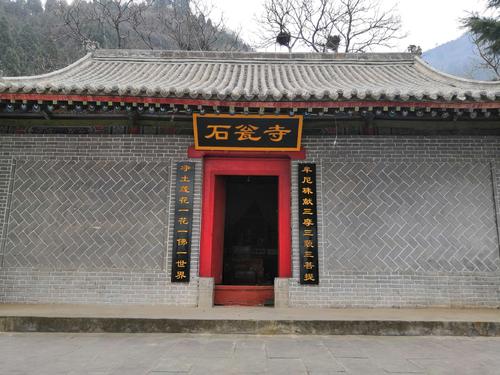
From the Shiweng Valley Waterfall to the east, you will arrive at Shiweng Temple. Because Concubine Yang believed in Buddhism, Emperor Xuanzong built Shiweng Temple on Lishan Mountains for her. So it was a royal Buddhist temple at that time. The Buddha statues in the temple were all made by the most skilful craftsmen at that time. There was originally a hand-carved white jade Buddha statue in the temple, but now this statue has been destroyed by the war and no longer exists.
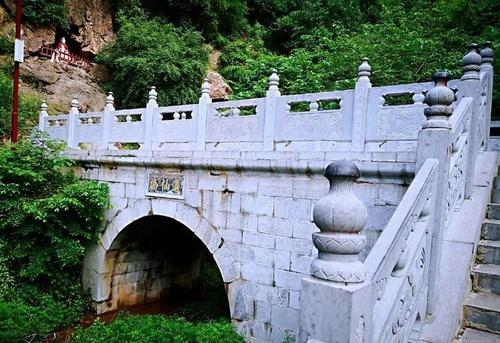
Located in the valley on the east side of the Lishan Mountains, this is a single-hole stone arch bridge with a length of 5 meters, a width of 2.4 meters, and a height of 5 meters. Yuxian Bridge was built in the Tang Dynasty and has a history of thousands of years. According to legend, a student of the Ming Dynasty went to Beijing to take the imperial examinations. When he passed by Xi’an, he stayed at Shiweng Temple to stay overnight. The next day he met the Eight Immortals on the bridge. The Eight Immortals gave him some guidance and then he got the No.1 in the examination. So, people called this bridge Yuxian Bridge, which means you can meet the immortal on this bridge. Standing on the bridge, you will see the beautiful natural scenery of the Lishan Mountains and the Shiweng Temple.

Built in 1981, the Sunset Pavilion is shaped in square with double eaves and a pointed roof. It is built for appreciating the brilliant sunset on Lishan Mountains. Standing on the north side of the pavilion, tourists can have a panoramic view of the Huaqing Pool. The setting sun on Lishan Mountains is one of the most popular sceneries here. Lishan Mountains will be covered with a layer of charming golden hue under the shine of the setting sun, which is rather a natural masterpiece. So many photographers come here to shoot the sunset glow.
Song of Everlasting Sorrow is a long poem about the love story between Emperor Xuanzong and his concubine Yang Yuhuan handed down by Bai Juyi, a famous poet in Tang Dynasty. From 2006 to 2007, the dance drama “Song of Eternal Sorrow” which is the first large-scale living historical drama in China was successfully staged in Huaqing Pool. From then on, every night from April to October, it is performed on time. With its large-scale work, production, and line-up, it brings vitality into Shaanxi tourism and provides new experiences and pleasure to tourists. More than 400 sets of costumes vividly show the characteristics and beauty of Tang Dynasty costumes for you and will take you to enter that graceful and luxurious Tang Dynasty.
The performance lasts 70 minutes and contains ten parts with the participation of 300 professional actors. The dance drama artistically reproduces this touching love story in its original place. With the help of modern technology and artistic means of expression, this performance has attracted countless tourists.
Besides, the dance drama has been performed for a number of foreign leaders and received high praise. People often use the Chinese proverb “This song should only be heard in heaven, but rarely on the earth.” to express their praise and love for the drama. The performance is so popular that the seats are always fully booked.
So, don’t miss out on the “Song of Everlasting Sorrow” performance when you visit the Huaqing Pool in Shaanxi..

The 1212·Xi’an Incident Performance is based on the “Xi'an Incident” that happened in the Huaqing Pool on December 12 in 1936, which consists of 10 scenes.
The purpose of the whole performance is to let the audience experience real history. The design of the entire stage breaks the traditional stage concept. The addition of bombed walls, broken plaques, and other elements make the stage more historical and more realistic. The moment the audience saw the stage, they were already drawn into the story. More importantly, the stage in front of the audience is not the only place where the performance is presented. 32 high-definition projectors allow images to be displayed on the roof of the theatre and the huge LED screen surrounding the auditorium. In this way, the audience can get a 360-degree viewing experience. In addition, there are many hidden devices in the theatre, which can spray smoke, strong wind, snowflakes, etc. according to the needs of the performance, which increases the personal experience of the audience. Coupled with the world's top French Mozart audio equipment, the audience seems to have experienced a real Xi'an incident together with the actors.
It is not recommended to travel on weekends or China's legal holidays because of too many people.
The Site of the Imperial Hot Spring of Tang Dynasty→Pear Garden→Nine-dragon Lake→Five Room Hall→Enjoy a hot spring bathing→ “Song of Eternal Sorrow” Performance
Pea Garden→Furong Garden→Frost Flying Hall→Climb the Lishan Mountains→Remonstrance Pavilion→Beacon Tower→Sunset Pavilion→ “Song of Eternal Sorrow” Performance
Take bus No.914 and No.915 from the East Plaza of the Shaanxi Railway Station and get off at Huaqing Pool Station.
Take bus No.306 from the East Plaza of the Shaanxi Railway Station. The journey is about 42 km, and the departure time is 7:00-18:00, with an interval of 15 minutes. It takes about 4.50 yuan.
If you start from Lintong District, you can take bus No.101.
Take metro line 1 to Fangzhicheng Station and then transfer to line 9. Get off at Huaqing Pool Station.
Chinese: 请带我去华清池。English: Please take me to Huaqing Pool.
If you go to the Huaqing Pool from the Xi’an North Station, it takes about 50 minutes (100 yuan).
If you go to the Huaqing Pool from the Xi’an South Station, it takes about 70 minutes (140 yuan).
If you go to the Huaqing Pool from the Xi’an West Station, it takes about 50 minutes (90 yuan).
If you go to the Huaqing Pool from the Xi’an East Station, it takes about 35 minutes (60 yuan).
